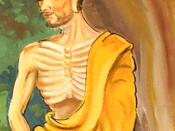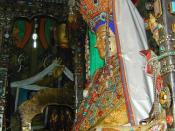Giving hints rather than a clear definition of what the metaphors signify is clearly Hesse's keen writing style. In Siddhartha, Herman Hesse leaves numerous ambiguities for the reader to decipher on his or her own. Such things as Kamala taking the songbird and letting it fly, Govinda turning into a woman, and what the river signifies are things left for the reader to ponder upon. One significant thing that Hesse leaves undefined is Siddhartha's inner voice, Atman. It is referred to a countless amount of times throughout the novel; however, Hesse does not explain what it is. Through careful reading and analysis of Siddhartha's character and thoughts, I am led to believe that Atman is not Siddhartha's soul or his conscience, but is his inner drive. Inner drive is an irritation that needs to be fulfilled. Siddhartha possesses this irritation because he wants to nothing else but to fulfill his goal.
This irritation is what motivates him to seek enlightenment. He goes through many rebirths to revive his drive so that he continues to seek enlightenment.
Hesse opens the novel by describing what Brahmins do and how Siddhartha understood Atman. He clearly shows that Siddhartha has an irritation of some sort to achieve his goal. Atman was vaguely defined as "his innermost being, indestructible, at one with the universe."ÃÂ Shortly thereafter, Atman is again referred to as "the Only One, the All-One."ÃÂ Then Siddhartha ponders "where did his eternal heart beat if not in one's own self, in the innermost, in the indestructible essence that every person bore within?"ÃÂ One person's inner drive can be indestructible when it overrides all other needs. One's inner drive can be "the Only One"ÃÂ if that person views life as solely achieving the goal that he or she is set to achieve.


